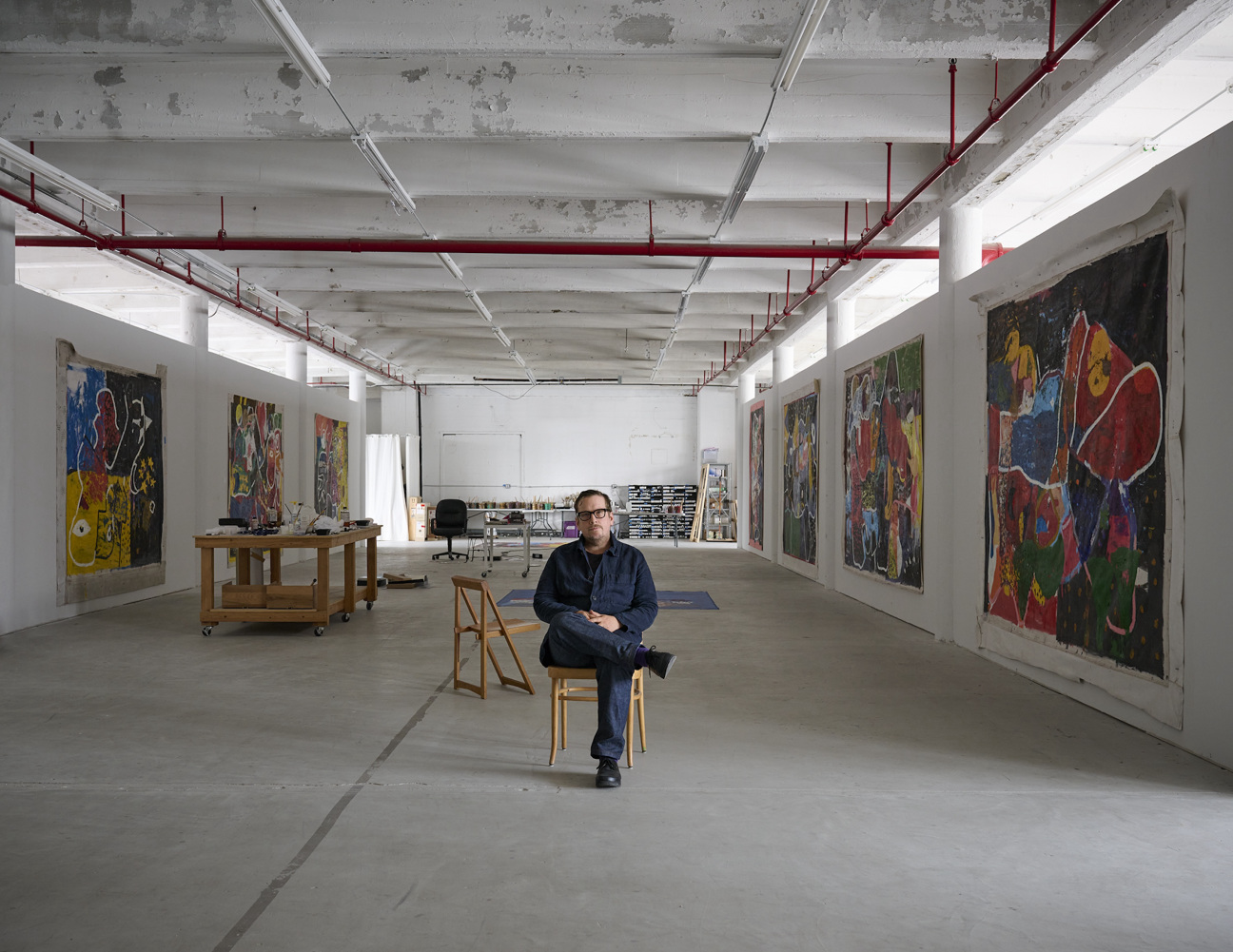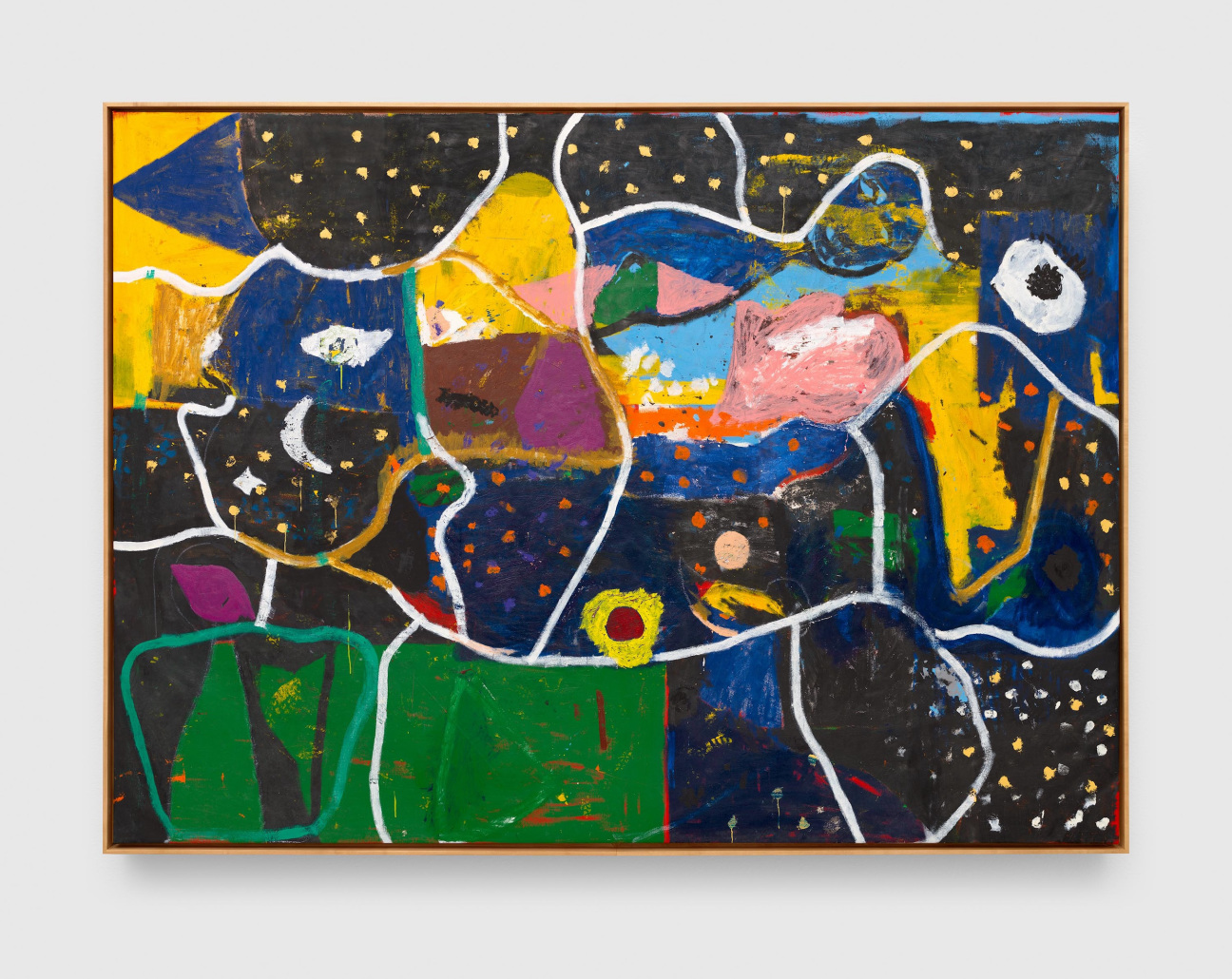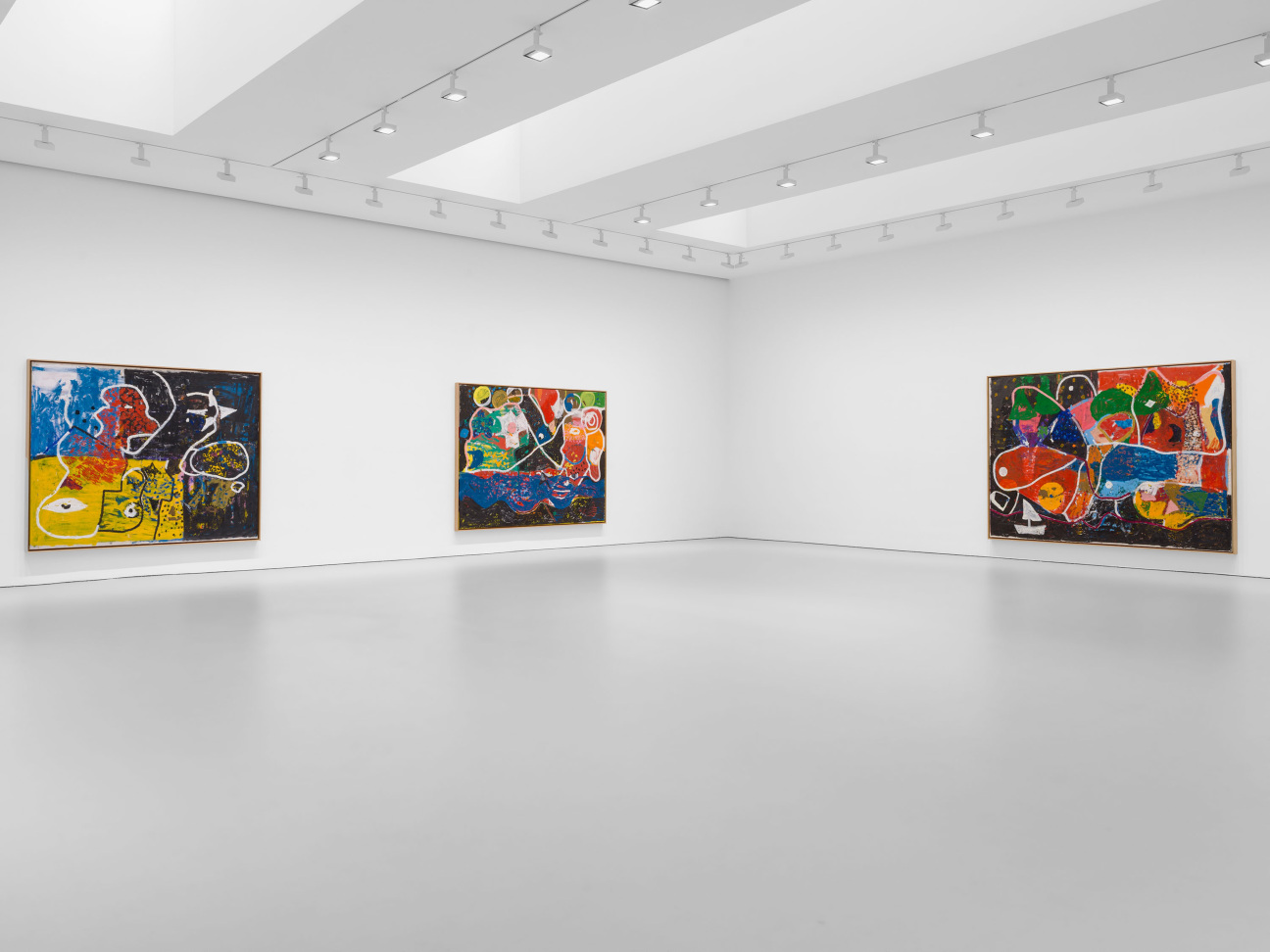
New York-based painter Joe Bradley often finds his work being compared to the late minimalist Ellsworth Kelly, whose geometric compositions feel neat and tidy. Bradley is his messier acolyte, his visible brush strokes breathing life into otherwise orderly work. Play, however, is paramount: Though Bradley oscillates between geometric abstraction and cartoonish figuration, a sense of levity comes through no matter where on the pendulum he swings.
This lightness is present in his latest show and David Zwirner debut “Vom Abend,” now on view through May 18 at the gallery’s West 19th Street location in New York. Even the title has a certain innocence: Bradley found the words in a German children’s book. “I don't speak German, but I thought ‘Vom Abend’ had a nice ring to it,” he adds.
Literally translated to “from the evening,” the work exhibited presents a more subdued Bradley. Deep blues and smokey black swathes underpin otherwise bold compositions, the overall effect slouching towards nighttime. Kalparush recalls a scattered night sky, while Salute presents a vague figure, its large eye looking off into the distance. Still, Bradley’s enjoyment comes through, even if in a twilight.
For his David Zwirner debut, Bradley spoke to CULTURED about the title of his show, why all art is fair game for reinterpretation, and the role of humor in his practice.

CULTURED: You’ve explored various artistic styles and mediums throughout your career, from monochromatic formations to more vibrant, dynamic compositions. Do you see your current work in conversation with your earlier output?
Joe Bradley: I don’t really think about my early stuff that much, but it is there. I try to stay focused on what I’m working on now. Sometimes something will resurface. When I finished hanging this new show, I looked around and thought, These paintings have something in common with the “Schmagoo” show, paintings I made back in 2008. But this came as a surprise. It wasn’t something that I had set out to revisit.
CULTURED: Your method of painting flat on the floor allows for intervention and imperfection: Dirt, accidental marks, and even studio detritus get on the canvas. How did you arrive at this method, and what are you trying to communicate with it?
Bradley: For the most part, these paintings were made upright, tacked to the wall. I did work for a number of years with the canvas flat on the floor, which could lead to some interesting results, but after a while I got sick of crawling around on my hands and knees.
CULTURED: Your work is often put in conversation with that of Cy Twombly or Joan Miró. How does engaging with the works of artists like Twombly or the Primitivists influence your creative process?
Bradley: As far as I can tell, art is made of art, almost entirely. One of the real pleasures of looking at art, particularly in painting, is in locating where the artist sees themselves in terms of lineage. Who is the artist looking at, and what are they doing with that influence? I think artists understand this. You look at art history and find what you need. It is all fair game.
CULTURED: Intuition factors into your art practice. What is its role? Is it a guide, a savior, both?
Bradley: Intuition is everything. The thinking mind, the rational, problem-solving mind, tends to get in the way of things, so half the battle in the studio is in keeping that thing in check.

CULTURED: “Vom Abend” is your debut with David Zwirner. What are you most looking forward to about this chapter in your career?
Bradley: I feel very lucky. I am super happy to be working with Zwirner. They have put together an incredible program: It’s really an honor to be included. In the studio, things are moving along. The work has a life of its own. I think I’m going to work on some small paintings this summer, and I would like to focus a bit on sculpture.
CULTURED: The translation of “Vom Abend” means “from the evening,” indicating that we are leaving a liminal or transitional time of day. How did you arrive at this title? Do you think this work indicates that you are transitioning out of something?
Bradley: I got the title from an old German children's book, Vom Abend zum Morgen. My wife collects these things, and this one is full of beautiful little drawings of gnomes, so I brought it to the studio. I don't speak German, but I thought "Vom Abend" had a nice ring to it. When I heard the translation, “from the evening,” I felt it jived really well with the work. The paintings in “Vom Abend” have a sort of nocturnal feel, and I like the idea of painting as a way of pulling something out of darkness and into light.
CULTURED: The show is, in many ways, about accumulation, with the paintings being created over several years. How did this focus on time and change differ from your earlier work? Have you always wanted to be patient with your process?
Bradley: I have made fast paintings in the past, one-shot sort of things that were meant to happen very quickly. But these paintings I wanted to have a certain surface quality and texture that I couldn't get in a day or a week or a month. They really need to build up over time. I like the idea of a painting that is improvised, that is loose and playful but also a product of sustained focus and attention over a long period of time.
CULTURED: Line has reemerged within your work after it really not factoring into your oeuvre for some time. Was this an intentional reemergence or a factor of a long gestation period? Intuition, perhaps?
Bradley: I hadn't allowed a lot of drawing in my paintings for a few years. I don't know why. Sometimes you make a rule for yourself and the rule overstays its welcome. A few years ago, I had really hit a wall with the work, letting drawing back in really freed things up, like I had been painting with one hand tied behind my back.

CULTURED: “Vom Abend” overall has indicated a return to more recognizable forms within your painting. Did something in particular prompt this shift away from total abstraction?
Bradley: I have never really felt comfortable calling myself an abstract painter. There have always been flashes of figuration in my work. For whatever reason, at this moment, I feel ready to let it all come to the surface.
CULTURED: As noted in the press release for the show, there is “unassuming yet assertive sense of compositional balance” within the paintings. Given that you worked on these for several years, when did you know you reached that balance?
Bradley: Each painting is resolved in its own way, and it can be difficult to put a finger on when a painting is finished. When a painting needs work, you just know. Some part of the picture will feel out of place, or annoying in a way that draws attention and undermines the whole. At this point, you have to decide whether to incorporate the problem into the painting or to fix it. Oftentimes, the fix ends up making things worse, and you have another, new problem. You keep this dance up until you find yourself in a “checkmate” situation.
CULTURED: Humor and irony recur throughout your work, this latest show being no exception. What is your relationship to humor, and how has it evolved over time?
Bradley: Looking at art can be tedious, like being reminded to eat your vegetables. A bit of levity built into a work of art is a way of relieving tension, signaling to the viewer that it is ok to relax, look and maybe even enjoy!
“Vom Abend" is on view through May 18, 2024 at David Zwirner's West 19th Street location in New York.










 in your life?
in your life?

